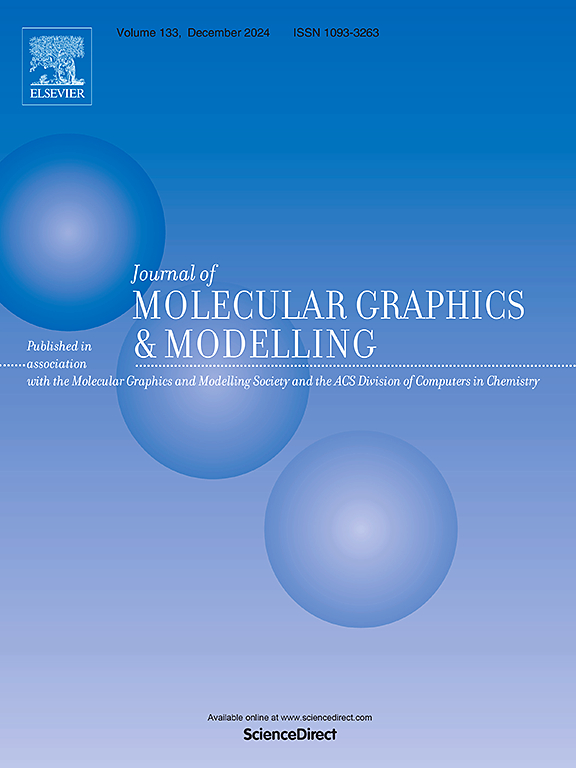Computer-aided drug design approaches for the identification of potent inhibitors targeting elongation factor G of Mycobacterium tuberculosis
IF 2.7
4区 生物学
Q2 BIOCHEMICAL RESEARCH METHODS
引用次数: 0
Abstract
Elongation factor G (EF-G) is essential for protein synthesis in Mycobacterium tuberculosis (Mtb), positioning it as a promising target for anti-tubercular drug development. This study employs Structure-Based Drug Design (SBDD) to identify potential small molecule inhibitors that specifically target EF-G. Initially, binding hotspots on EF-G were pinpointed, and the binding modes of various compounds were analyzed. Through protein-protein interaction studies, several promising candidates were validated. Virtual screening and molecular docking techniques were utilized to evaluate the binding affinities and interactions of 20 candidate molecules with Mtb EF-G. Additionally, toxicity profiles of these compounds were assessed using predictive models, which indicated non-carcinogenic properties. To further refine the selection process, Support Vector Machine (SVM) and Random Forest models were applied to predict cell wall permeability. Notably, Asinex (8853) and Asinex (102619) emerged as top candidates, boasting high probability scores for effective permeability. Molecular docking and molecular dynamics (MD) simulations revealed that Asinex (8853), Asinex (102619), and Otava (79226) exhibited strong binding affinities and favorable conformations within the active site of Mtb EF-G. These findings suggest that these compounds have significant potential as inhibitors, warranting further investigation into their efficacy as novel anti-tubercular agents. Overall, this study emphasizes the value of Structure-Based Drug Design in identifying promising therapeutic candidates against tuberculosis by targeting essential bacterial factors like EF-G.

计算机辅助药物设计方法鉴定针对结核分枝杆菌延伸因子G的有效抑制剂。
延伸因子G (EF-G)对结核分枝杆菌(Mtb)的蛋白质合成至关重要,使其成为抗结核药物开发的一个有希望的靶点。本研究采用基于结构的药物设计(SBDD)来鉴定特异性靶向EF-G的潜在小分子抑制剂。首先,确定了EF-G上的结合热点,并分析了各种化合物的结合模式。通过蛋白质相互作用的研究,几个有希望的候选药物得到了验证。利用虚拟筛选和分子对接技术对20个候选分子与Mtb EF-G的结合亲和力和相互作用进行了评价。此外,使用预测模型评估了这些化合物的毒性特征,表明它们具有非致癌性。为了进一步细化选择过程,应用支持向量机(SVM)和随机森林模型预测细胞壁渗透率。值得注意的是,Asinex(8853)和Asinex(102619)在有效渗透率方面的概率得分很高,成为首选。分子对接和分子动力学(MD)模拟结果显示,Asinex(8853)、Asinex(102619)和Otava(79226)在Mtb EF-G活性位点表现出较强的结合亲和力和有利的构象。这些发现表明,这些化合物具有显著的抑制剂潜力,值得进一步研究其作为新型抗结核药物的功效。总的来说,这项研究强调了基于结构的药物设计的价值,通过靶向EF-G等必要的细菌因子来确定有希望的治疗结核病的候选药物。
本文章由计算机程序翻译,如有差异,请以英文原文为准。
求助全文
约1分钟内获得全文
求助全文
来源期刊

Journal of molecular graphics & modelling
生物-计算机:跨学科应用
CiteScore
5.50
自引率
6.90%
发文量
216
审稿时长
35 days
期刊介绍:
The Journal of Molecular Graphics and Modelling is devoted to the publication of papers on the uses of computers in theoretical investigations of molecular structure, function, interaction, and design. The scope of the journal includes all aspects of molecular modeling and computational chemistry, including, for instance, the study of molecular shape and properties, molecular simulations, protein and polymer engineering, drug design, materials design, structure-activity and structure-property relationships, database mining, and compound library design.
As a primary research journal, JMGM seeks to bring new knowledge to the attention of our readers. As such, submissions to the journal need to not only report results, but must draw conclusions and explore implications of the work presented. Authors are strongly encouraged to bear this in mind when preparing manuscripts. Routine applications of standard modelling approaches, providing only very limited new scientific insight, will not meet our criteria for publication. Reproducibility of reported calculations is an important issue. Wherever possible, we urge authors to enhance their papers with Supplementary Data, for example, in QSAR studies machine-readable versions of molecular datasets or in the development of new force-field parameters versions of the topology and force field parameter files. Routine applications of existing methods that do not lead to genuinely new insight will not be considered.
 求助内容:
求助内容: 应助结果提醒方式:
应助结果提醒方式:


